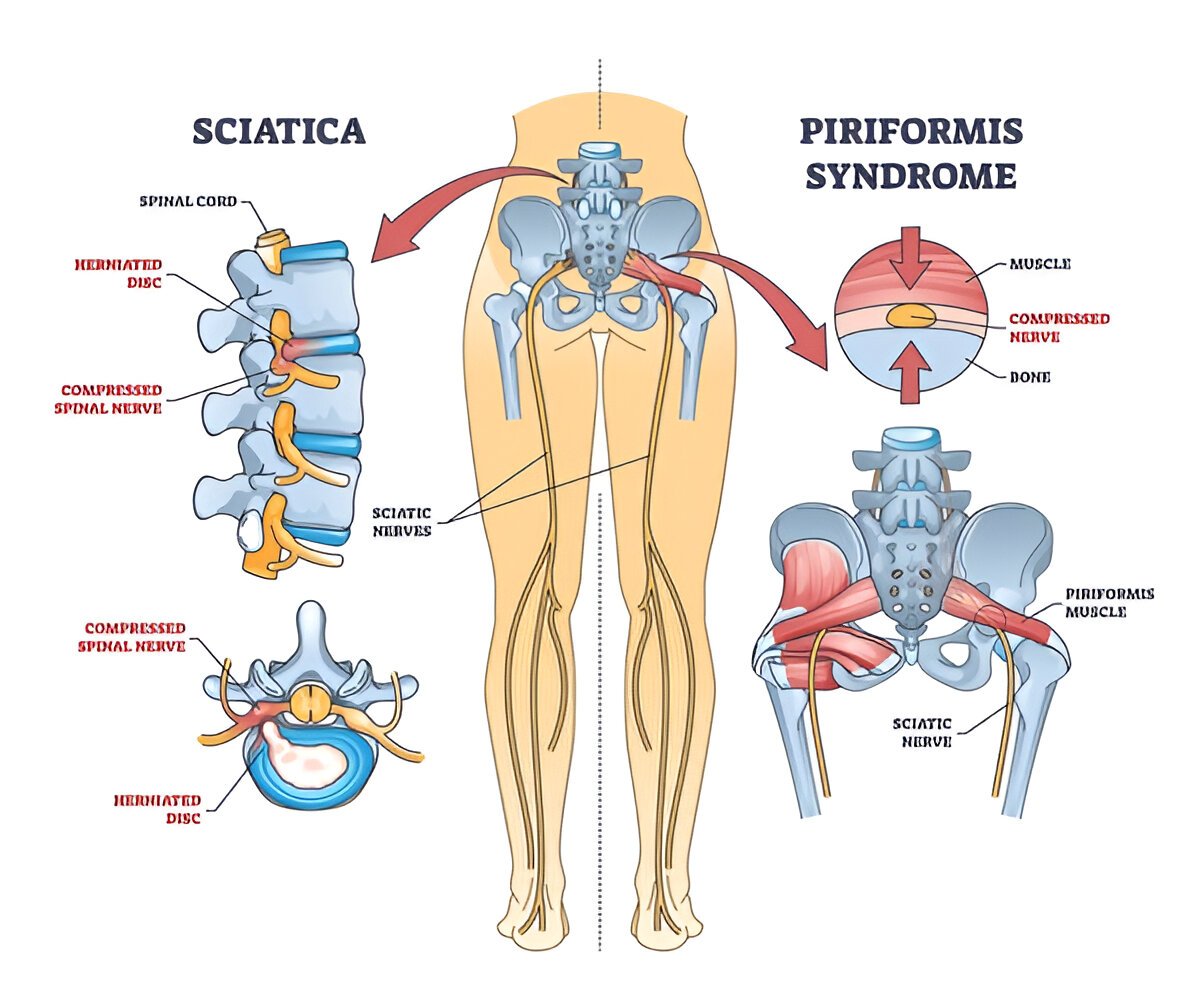Piriformis Syndrome
If you’ve been experiencing buttocks muscle pain, sharp aches in your lower back, or discomfort spreading into your legs, you might have Piriformis syndrome. Many people mistake it for sciatica or general back pain, but the real cause is often the small but powerful piriformis muscle deep in your buttocks.
At Rapid Physiocare, we help patients across Singapore diagnose the root cause of their pain and create customised treatment plans to relieve symptoms, restore mobility, and prevent flare-ups.
What is Piriformis Syndrome?
The piriformis is a narrow, band-like muscle that sits behind the hip joint. It helps to rotate the hip and stabilise the pelvis during walking or running. But when this muscle becomes tense or inflamed, it can press on the nearby sciatic nerve, leading to piriformis syndrome.
Common symptoms include:
- Pain in the lower back and buttocks when sitting for long periods
- Sharp or burning pain down the leg (often mistaken for sciatica)
- Lower back and glute pain that worsens with movement
- Muscle tightness or soreness in the muscle on top of the buttocks
Think of the piriformis muscle as a “gate keeper” for the sciatic nerve. When it tightens ormis behaves, it blocks smooth signals and causing you to get pain, tingling, or numbness.

Piriformis Syndrome vs Sciatica
What’s the difference between piriformis syndrome and sciatica? Even though their symptoms overlap, there’s a key difference. Sciatica usually comes from a spinal issue (like a herniated disc) while piriformis syndrome comes from the buttock itself.
If your pain worsens after sitting on hard surfaces or when climbing stairs, piriformis syndrome is often the culprit. Our physiotherapists are trained to distinguish between the two and guide you to the right treatment path.
Don’t Ignore These Symptoms
Ignoring piriformis syndrome symptoms means pain will persist and limit your daily activities. Here are the warning signs:
- Piriformis syndrome pain in the buttocks area
- Aches down the back of your thigh
- Discomfort when walking, sitting or lying down
- Piriformis syndrome: lower back pain linked to muscle tightness
Even sleep becomes difficult. If you’ve been Googling “how to sleep with piriformis syndrome,” it’s a sign you need more than temporary fixes; you need professional care.

Treatment Options at Rapid Physiocare
Piriformis syndrome physiotherapy is the way to go. At Rapid Physiocare, we use hands-on techniques, stretching protocols, and progressive strengthening to reduce tension and increase mobility.Unlike quick fixes that mask the pain, our approach gets to the root of the problem.
Your treatment plan may include detailed movement assessments to identify the exact cause of irritation whether it’s muscle tightness, posture imbalance, or nerve compression from daily habits. Our physiotherapists take time to understand how your pain started and how it affects your movement patterns. This helps us design a program that doesn’t just treat symptoms but corrects the dysfunction causing them.
During your sessions, our specialists will combine targeted manual therapy and guided mobility work to ease tension around the piriformis muscle. You’ll also learn safe, evidence-based stretches and activation drills to retrain your muscles and restore natural hip alignment. Each phase of treatment is carefully progressed, so you improve without aggravating your pain. Your treatment plan may include:
1. Manual Therapy & Massage
Targeted piriformis syndrome massage releases tension and improves blood flow to the affected muscle. Combined with physiotherapy, it helps to speed up recovery.
2. Corrective Exercises
We guide you through, customised piriformis syndrome exercises that activate supporting muscles and reduce strain on the piriformis.
3. Lifestyle & Ergonomic Adjustments
Something as simple as poor sitting posture can trigger flare-ups. We’ll guide you with better habits from desk setup to sleeping positions so you won’t be left searching for ways to ease piriformis syndrome.
What Makes Our Approach Different?
At Rapid Physiocare, we don’t just chase symptoms; we get to the bottom of why the piriformis muscle is causing trouble in the first place. Our physiotherapists combine years of clinical experience with modern tools to deliver results.
You’ll get:
- Personalised care → No one size fits all.
- Hands-on techniques that work instantly.
- Progress tracking so you can see results over time.
- Long-term solutions to prevent it from coming back.
Most importantly, you’ll walk out not just feeling better but knowing how to keep yourself pain-free.
Can Piriformis Syndrome Heal Quickly?
With the right treatment most people feel better within weeks. Conservative management like targeted physio and guided exercise works faster than medication alone.
Without treatment, though, the pain can become chronic. That’s why early intervention matters.
Self-Care Management
While professional treatment is essential, here are a few things you can do at home:
- Use a firm cushion when sitting to reduce pressure on the butt.
- Try gentle stretches, but don’t push into pain.
- Alternate between sitting and standing throughout the day.
- Apply ice or heat packs for short-term relief.
These will help temporarily but the real solution lies in addressing the root cause.
Success Stories
Many of our patients thought it was just back pain until proper diagnosis revealed piriformis syndrome. With our treatment plans, they resume back to jogging, doing yoga, or simply sitting comfortably again activities they thought were gone for good.
Take the First Step Toward Relief
Living with ongoing piriformis syndrome pain can be frustrating, but it doesn’t have to be permanent. Our team at Rapid Physiocare can guide you with proven patient-focused solutions.
Don’t let pain control your routine—take action now.
Book now and start your journey to lasting relief. Prefer a quick chat first? Call us today to speak with our friendly team.
Frequently Asked Questions
What is the best treatment for piriformis syndrome?
The most effective treatment combines targeted physiotherapy, specific stretching and strengthening routines and lifestyle adjustments. Physiotherapy works to release the tension in the piriformis muscle, restore mobility, and prevent the sciatic nerve from being compressed. In practice, this means hands-on therapy, guided exercises, and ergonomic coaching so you can move without pain and keep flare-ups from coming back.
What should you avoid if you have piriformis syndrome?
Avoid sitting for long hours on hard surfaces, slouching, or doing sudden twisting movements without warming up. Activities that overload the glutes, like running on uneven ground or heavy lifting with poor form can also irritate the piriformis muscle. A good rule: if a movement causes a sharp pinch or burning in the buttock or lower back, scale it down until you’ve built up proper support through treatment.
Is walking good for piriformis syndrome?
Yes, in most cases walking is actually beneficial. Gentle walking helps keep blood flowing, reduces stiffness, and activates supporting muscles around the hips and core. The key is to start slow, keep strides even, and avoid hills or uneven paths until you’ve improved flexibility and control. Think of walking as part of your rehab toolkit—but not the only tool. Pair it with guided stretching and strengthening for best results.
What is the main cause of piriformis syndrome?
Piriformis syndrome usually develops when the piriformis muscle tightens or becomes overworked, pressing on the sciatic nerve. This can happen due to prolonged sitting, poor posture, repetitive movements like running or cycling, or even muscle imbalances from weak hips or core. In short, it’s often a mix of lifestyle habits and biomechanics rather than a single “injury.”
What is the best sleeping position for piriformis?
The goal is to reduce pressure on the piriformis and sciatic nerve. Many people find relief by sleeping on their back with a pillow under the knees or on their side with a pillow between the legs. Both positions keep the hips aligned and prevent the piriformis from tightening overnight. Avoid lying flat on your stomach; it twists the spine and adds tension to the glutes.
How long does it take for piriformis to heal?
Recovery time depends on how long the condition has been left untreated and how consistent you are with therapy. With proper physiotherapy and home care, many patients notice improvement within a few weeks. For long-standing cases, it can take a few months of structured treatment to fully resolve. The faster you start treatment, the faster your body responds.
What happens if I ignore piriformis syndrome?
Ignoring piriformis syndrome can turn a manageable condition into a chronic, long-term problem. The muscle tightness can worsen, nerve compression can become more severe, and simple activities like sitting, walking, or sleeping may feel uncomfortable every day. Over time, you may also develop compensations in other muscles, leading to hip or lower back issues. Addressing it early prevents this domino effect and helps you get back to living pain-free.

